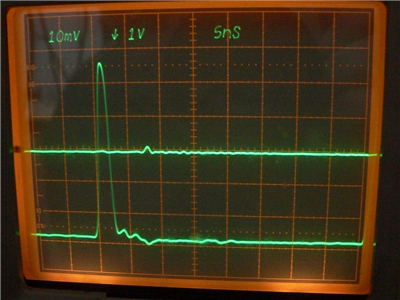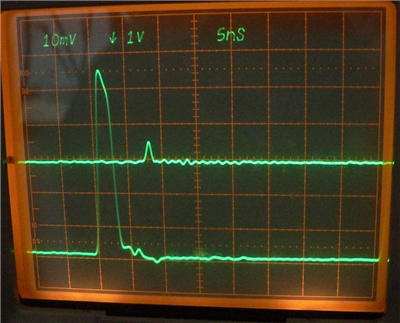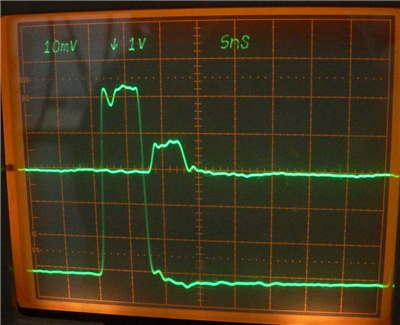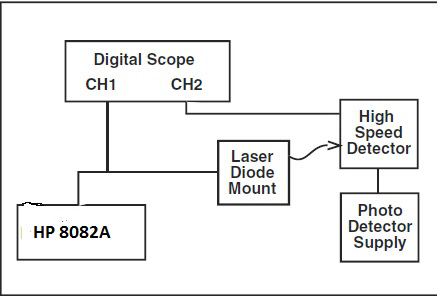
Pulse width of a red laser diode as a function of the width of the corresponding electrical pulse
Physikfan, Sun Dec 18 2016, 05:20PMHi
In the experiment for determining the speed of light with the aid of a pulsed red diode laser,
I found out that a relatively broad electrical pulse (about 6 ns) could generate a relatively small laser pulse (about 1 ns).
In order to study this phenomenon, I have made further experiments with differently wide electrical pulses, the amplitude being 5.5 V plus 2 V bias DC at 50 Ohm.
For each electrical pulse width, the laser pulse width as well as the amplitude were determined with a Si photodiode with a rise or fall time of 150 ps.
The oscilloscope was an analog Tektronix with a 7904 frame and twice 7A19 and a 7B10, (500 MHz bandwidth).

At approximately two nanoseconds of electrical pulse width, a very small and narrow laser pulse with about 2 mV amplitude is obtained at the detector.

At approximately three nanoseconds of the electrical pulse width, a laser pulse of about 6 mV amplitude and 1 ns pulse width is obtained at the detector.

At approximately six nanoseconds of the electrical pulse width, a laser pulse with an amplitude of about 8 mV and a pulse width of 4 ns is obtained at the detector.

At approximately 15 nanoseconds of the electrical pulse width, a laser pulse of about 10 mV amplitude and 13 ns pulse width is obtained at the detector.
Please, who has ideas how to explain this phenomenon?
Re: Pulse width of a red laser diode as a function of the width of the corresponding electrical pulse
Sulaiman, Mon Dec 19 2016, 08:33AM
can you give a link to laser-diode and photo-diode datasheets
and an idea of the physical setup
Sulaiman, Mon Dec 19 2016, 08:33AM
can you give a link to laser-diode and photo-diode datasheets
and an idea of the physical setup
Re: Pulse width of a red laser diode as a function of the width of the corresponding electrical pulse
johnf, Mon Dec 19 2016, 06:22PM
I gave you the explanation in your other post about this setup.
capacitance of the setup, source impedance of your driver. see my previous post
johnf, Mon Dec 19 2016, 06:22PM
I gave you the explanation in your other post about this setup.
capacitance of the setup, source impedance of your driver. see my previous post
Re: Pulse width of a red laser diode as a function of the width of the corresponding electrical pulse
Physikfan, Mon Dec 19 2016, 09:49PM
Hi Sulaiman
The interesting facts are that
1. the difference between the electrical pulse width and the optical pulse width is almost constant (2ns) and
2. almost independent of the electrical pulse width.
The specs of the laser diode are:
The laser diode is a Mitsubishi ML101U29,
maximum CW power 150 mW,
maximum pulse power 400mW,
wave length 660 nm,
threshhold current 85mA,
At 120 mW CW power the operating current is 205 mA, the operating voltage is 2.35V

The Si-photodiode is a Thorlabs DET025AL/M:
Detector Si
Active Area Diameter Ø 250 μm
Wavelength Range 400 to 1100 nm
Peak Wavelength 730 nm (Typ.)
Diode Capacitance 1.73 pF (Max)
Cutoff Frequency 2 GHz (Max)
Rise Time 150 ps (Typ.)
Fall Time 150 ps (Typ.)
Damage Threshold 18 mW
Dark Current 35 pA
Output Voltage 0 to 2 V (50Ω)

The experimental setup will follow.
Physikfan, Mon Dec 19 2016, 09:49PM
Hi Sulaiman
The interesting facts are that
1. the difference between the electrical pulse width and the optical pulse width is almost constant (2ns) and
2. almost independent of the electrical pulse width.
The specs of the laser diode are:
The laser diode is a Mitsubishi ML101U29,
maximum CW power 150 mW,
maximum pulse power 400mW,
wave length 660 nm,
threshhold current 85mA,
At 120 mW CW power the operating current is 205 mA, the operating voltage is 2.35V

The Si-photodiode is a Thorlabs DET025AL/M:
Detector Si
Active Area Diameter Ø 250 μm
Wavelength Range 400 to 1100 nm
Peak Wavelength 730 nm (Typ.)
Diode Capacitance 1.73 pF (Max)
Cutoff Frequency 2 GHz (Max)
Rise Time 150 ps (Typ.)
Fall Time 150 ps (Typ.)
Damage Threshold 18 mW
Dark Current 35 pA
Output Voltage 0 to 2 V (50Ω)

The experimental setup will follow.
Re: Pulse width of a red laser diode as a function of the width of the corresponding electrical pulse
Physikfan, Mon Dec 19 2016, 10:19PM
Hi Johnf
You wrote:
"your pulse if the area under it is intergrated that is the loule amount
now put that amount into an unknown capacitor q=CV so now you can estimate the capacitance by reducing the area under the pulse so that V or voltage does not get above the lasing threshold of your device.
dont forget the capacitance includes the cables pcb and the laser diode itself.
work backwards you do not need too much capacitance upset the diode output"
Unfortunately there is no value of the laser diode capacitance in the data sheet.
Does your explanation allow also this asymmetrical behavior between the electrical and the laser pulse, this difference of almost constant 2 ns?
Physikfan, Mon Dec 19 2016, 10:19PM
Hi Johnf
You wrote:
"your pulse if the area under it is intergrated that is the loule amount
now put that amount into an unknown capacitor q=CV so now you can estimate the capacitance by reducing the area under the pulse so that V or voltage does not get above the lasing threshold of your device.
dont forget the capacitance includes the cables pcb and the laser diode itself.
work backwards you do not need too much capacitance upset the diode output"
Unfortunately there is no value of the laser diode capacitance in the data sheet.
Does your explanation allow also this asymmetrical behavior between the electrical and the laser pulse, this difference of almost constant 2 ns?
Re: Pulse width of a red laser diode as a function of the width of the corresponding electrical pulse
johnf, Tue Dec 20 2016, 06:35PM
you can get a feel for how much the capacitance is by adding some more. ie put a 47pf cap across your diode and see what change the brings.
No change go for 470pf --if still no change 4700pf I doubt you will need to get to 4700pf. As for the assymetry does the driver source and sink current or does it only source, if it only sources then the assymetry is probably due to the stray capacitance.
johnf, Tue Dec 20 2016, 06:35PM
you can get a feel for how much the capacitance is by adding some more. ie put a 47pf cap across your diode and see what change the brings.
No change go for 470pf --if still no change 4700pf I doubt you will need to get to 4700pf. As for the assymetry does the driver source and sink current or does it only source, if it only sources then the assymetry is probably due to the stray capacitance.
Re: Pulse width of a red laser diode as a function of the width of the corresponding electrical pulse
Physikfan, Wed Dec 21 2016, 04:46PM
Hi Johnf
I will do these experiments.
This is my experimental setup:

In the paper "Pulsing a Laser Diode" by Doug Hodgson, Kent Noonan, Bill Olsen, and Thad Orosz
they published a figure with an electrical pulse, 1V/cm, feeding the laser diode and also the laser pulse, 10mV/cm, x-axes is 50 ns/cm.
As you can see the electrical pulse width is 200 ns, whereas the laser pulse with is only 180 ns, difference is 20 ns, similar to my experiment, difference is 2 ns:

There is also a new question:
Why is the difference 2 ns in my case?
Even the authors of the Newport paper did not
mention their 20 ns!
Both figures are taken from:

Please, what is your explanation?
Physikfan, Wed Dec 21 2016, 04:46PM
Hi Johnf
I will do these experiments.
This is my experimental setup:

In the paper "Pulsing a Laser Diode" by Doug Hodgson, Kent Noonan, Bill Olsen, and Thad Orosz
they published a figure with an electrical pulse, 1V/cm, feeding the laser diode and also the laser pulse, 10mV/cm, x-axes is 50 ns/cm.
As you can see the electrical pulse width is 200 ns, whereas the laser pulse with is only 180 ns, difference is 20 ns, similar to my experiment, difference is 2 ns:

There is also a new question:
Why is the difference 2 ns in my case?
Even the authors of the Newport paper did not
mention their 20 ns!
Both figures are taken from:

Please, what is your explanation?
Print this page